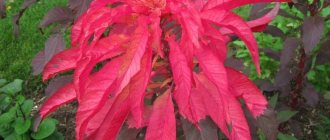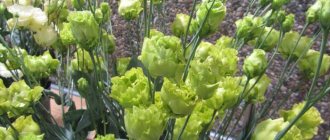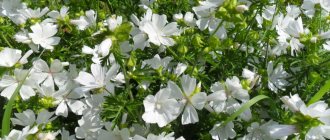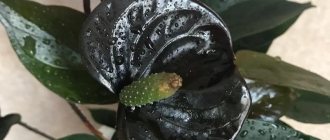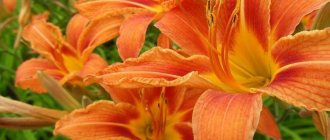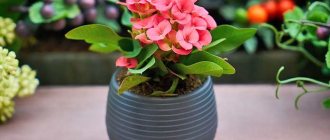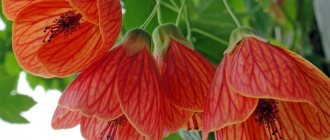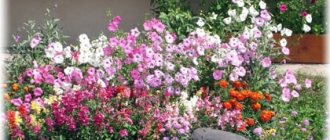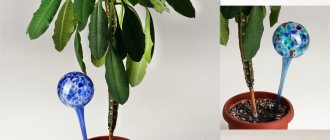If you are more attracted to greenery rather than flowers in indoor plants, feel free to choose reo: this crop blooms really modestly, but its leaves are very beautiful.
True, the concept of “green” can be applied to them with some stretch.
Painted in two primary colors (for example, green on the front side and purple on the back), they are dotted with many stripes of other, additional shades, which makes the plant especially elegant.
Description of features
The rheo flower (in Latin called Rhoeo Hance) belongs to the species “Tradescantia variegated”. Sometimes they write “reo”, it is often called reo tepalata , because its already modest, inconspicuous flowers managed to hide under the leaves-bracts, as if under a blanket.
This botanical feature caused people who studied the plant to associate it with a mythological boat that floated down the Nile, in which lay a baby. It was discovered and saved by an Egyptian princess, and the plant was named reo (by the way, Reo is the name of a forest nymph) and began to be called “Moses’ boat” or “Moses in a basket.”
In its homeland, in the tropical zone, the plant does not know periods of rest. This, however, does not mean that there the reo rolls around like cheese in butter: in dry times, it has to fight for life, using the moisture previously accumulated in the succulent leaves.
At home, this amazing property of the plant helps it stay fresh all year round. And the leaves are truly unique: their length ranges from 25 to 30 cm, width – 5 cm, and thickness – 0.5 cm. Thanks to these parameters, even a single plant, if it is also well-formed, makes a rich, lush bouquet.
Reo variegated (bedspread)
Reo is a perennial crop that is quite easy to care for . In home floriculture, this species is used more often than others. The leaves are dense, shiny, violet-purple on the “underside” and dark green, with longitudinal white stripes on the “front” side.
The flowers (by the way, they can appear at any time of the year) are white and quite spectacular, even despite their miniature size. The “trunk” of the rheo is voluminous enough that, like the “crown,” it contributes to the accumulation of fluid reserves.
The reo palette can also include colors that are unusual for leaves, such as pink or pink (Stripe in Pink variety), burgundy (Compacta).
Reo yellow
Reo yellow is not so often used in indoor floriculture, perhaps because yellow colors create the illusion of fading autumn foliage, and we want fresh, spring colors.
Nevertheless, this type of reo looks very original.
For example, the Vittata variety (as pictured) impresses with its combination of dark purple and intense yellow color.
In the spathacea Vittata variety, the beautiful sandy shade has completely replaced the purple colors.
There are also varieties with a beige color.
LiveInternetLiveInternet
–Categories
- Knitting (1518)
- We knit for children. (136)
- Websites. (1)
- For dogs and cats. (7)
- Toys, amigurumi. (110)
- Irish lace. (60)
- Hook (200)
- Machine knitting. (7)
- Designations for diagrams. (17)
- Clothes for toys. (6)
- Finishing and assembling knitted products. (22)
- Romanian lace. (2)
- Knitting needles, hooks (hats, scarves, socks, mitts, etc.) (158)
- Knitting needles. (327)
- Crochet patterns, lace. (103)
- Knitting patterns. (83)
- Crochet lessons. (71)
- Learning to knit. (112)
- Tatting. (2)
- Freeform. (5)
- Art school. (5)
- We do it ourselves (54)
- Children. (46)
- Coloring pages, games. (12)
- Animals. (6)
- Horses. (1)
- Interesting (32)
- Online stores. (1)
- Art. (2)
- Yorkshire Terrier. (0)
- How to create your own website. (2)
- pictures with codes. (8)
- Indoor flowers. (19)
- Computer, Internet, software (38)
- Beautiful pictures. (61)
- Beauty and health (212)
- oncology (9)
- Music. (6)
- Making a diary. (23)
- VERY IMPORTANT. READ. (8)
- Hair salon at home. (thirty)
- Useful tips. (47)
- Psychology. (4)
- Travel around the planet (44)
- Patchwork. (eleven)
- Relaxation. (0)
- Religion. (6)
- Recipes (1038)
- main courses with meat (144)
- Links to culinary sites. (1)
- Baked goods (pies, pies, buns, bagels) (212)
- Side dish (8)
- Dessert (cakes, sweets, etc.) (218)
- Home wine. (2)
- Breakfast. (87)
- Preparations for the winter. (70)
- Chicken. (7)
- Vegetables. (59)
- Useful tips. (10)
- Recipes (links) (2)
- Fish. (12)
- Sauces. (18)
- Spices (2)
- Soup. (37)
- Table of weights and measures in cooking. (3)
- Bread. (32)
- Cold appetizers. (126)
- Needlework. (557)
- Filigree, sken. (9)
- Baubles. bracelets. (3)
- Batik. (2)
- Bijouterie. (31)
- Beading (71)
- Felting wool. (eleven)
- Embroidery (72)
- Decorative modeling (19)
- For home (106)
- Handmade soap. (3)
- Weaving. (55)
- Crafts (194)
- Textile dolls (9)
- Spot painting. (7)
- Garden Garden. (72)
- links (8)
- Construction, architecture, renovation. (26)
- Wall painting in the interior. (4)
- Bags, cosmetic bags (46)
- LET'S SMILE. (1)
- Photoshop. (35)
- braggarts (1)
- We sew with pleasure (320)
- Basic patterns (9)
- Outerwear. (4)
- Baby clothes. (43)
- Women's clothing. (97)
- Sewing magazines. (2)
- Toys. (25)
- From old jeans. (7)
- Men's clothing. (7)
- Useful tips. (40)
- Websites for those who sew. (26)
- Size tables. Fabric calculation. (2)
Care
Although reo is not a capricious flower, it is very responsive to good care . If you take care of it according to all the rules, reo can become a real decoration for your home flower collection.
Light and temperature
Reo requires good lighting, but direct sunlight can be detrimental to it . The best choice is windows facing west and east.
If you place the reo plant on a southern windowsill, your green pet will need light shading. On northern windows, lighting may be required, because if the flower does not have enough light, its stems will begin to stretch.
ATTENTION : lack of light negatively affects the decorative properties of reo.
This plant should not be exposed to sudden temperature changes . We must try to maintain the air temperature around 20 degrees in summer and at least 15 in winter.
Watering
The amount of watering is adjusted depending on the season:
- from spring to autumn - intense,
- in winter – moderate.
The same approach can be applied to spraying - such water procedures are extremely pleasant for the plant, however, in the cold season they should be carried out less frequently, but not completely eliminated, since due to the operation of heating radiators in the room there is quite low air humidity.
Reo is a moisture-loving crop, so the soil in the pot should always remain moist.
And so that the roots do not suffer from excess moisture, you need to ensure high-quality drainage in advance.
A good option for increasing humidity levels is to place pots on trays filled with wet moss or pebbles.
By regularly adding water to the tray, you will be able to maintain the moisture level required by the plant. The water should be at room temperature and soft in composition. After half an hour or an hour, the water needs to be poured out of the pan.
Fertilizers and fertilizers
Reo needs fertilizers and fertilizing from the first month of spring to August inclusive. They need to be done once every two weeks. In autumn, the number of fertilizing is reduced, in winter - they are stopped completely.
The fact is that in a state of relative dormancy, the plant consumes less nutrients and they begin to accumulate in the soil, which can subsequently have a negative effect on the flower.
It is advisable to use complex mineral fertilizers, as well as organic fertilizers, strictly in accordance with the volumes specified in the instructions.
Experts warn: a plant can more easily tolerate a lack of fertilizer than an excess amount.
Transfer
Adult specimens do not require frequent replanting; it is enough to do it once every 3-4 years . With “youth” this procedure is carried out every spring, usually using the transshipment method. First, the top layer of “old” soil, in which there are no longer any nutrients left, is removed.
Each time the pot is taken a little larger than the previous one , and the shape is always chosen the same - with a large diameter and insignificant depth. The fact is that the rheo root system grows more actively in width than in length. Drainage must be laid at the bottom. For more information about rheo transplantation, watch this video:
Tall purple perennial flowers
Purple flowers (photos with names help to work out the location of the plants in advance), which grow to 100, 150 cm and higher, look very solemn and proud. They, like flowering plants of other shades, are a decoration of the garden.
Delphinium
Delphinium is a striking representative of tall, beautiful perennial flowers. It belongs to the ranunculaceae family. It gets its name from the shape of its unopened buds, which resemble the nose of a dolphin. The flowers have straight, stiff, single stems.
The plant can reach a height of 80 to 200 cm. The flowers, collected in inflorescences, form clusters and can be double or simple. Delphinium is a honey plant and has many varieties and varieties. Unpretentious, but does not like overly moist soil.
Lupine
Lupine is a tall plant from the legume family. It can grow up to 100-150 cm. It has a hard, leathery stem and oval-shaped leaves. The inflorescences resemble a pointed cluster of many small flowers.
At the end of flowering, formations appear on the lupins that resemble beans, inside of which there are seeds. The first shoots of the plant appear in the spring, and flowering occurs at the end of July.
Phlox
Phlox are garden flowers with a delicate aroma. Some varieties are tall. Plants planted simultaneously in large numbers look very beautiful. They tolerate cold climates well.
Phlox inflorescences are collected in pointed panicles of many beautiful five-petaled flowers. The stems of the plant are strong, and the roots reach depths of up to 40 cm.
The tallest of all types of phlox is the Bonnie Maid variety. It has the largest flowers and a wonderful aroma. Very beautiful flowers of the Dragon variety. They have a purple-violet color. It does not bloom for a very long time, but it is resistant to frost and does not require shelter.
The plant world is very diverse. Flowers with purple shades have different names and are presented in all their splendor and originality. Even the best photographs cannot convey all their beauty.
Reproduction
Nature itself has come up with a very convenient way of reproduction for rheos - by lateral shoots. In the tropics, this gives the plant the opportunity to easily and quickly expand its habitat.
At the same time, the varietal characteristics of the maternal rheo are completely preserved.
This rule is not violated in the process of home breeding.
However, flower growers like to experiment, which means you can try to increase the “plantations” of reo by sowing seeds.
Seeds
If the plant has received enough solar heat and moisture, the seeds ripen well.
Before planting, they are soaked in water with the addition of a growth-stimulating drug.
A day later they begin planting.
There is no need to press the seeds into the soil; just sprinkle a 2-mm layer of soil on top.
Using a plastic bag, they build a kind of greenhouse and patiently wait (moistening the soil from time to time) for two to six weeks for seedlings to appear.
All this time, it is advisable to maintain the temperature in the room at 20-22 degrees. The “greenhouse” is removed after the formation of two true leaves.
Diseases
If a houseplant does not look entirely healthy, try to understand the reasons and, if possible, eliminate them:
- small leaves - lack of nutrition and light;
- yellow spots – sunburn;
- growth retardation and loss of basal leaves - excess moisture;
- pale colors, thin long stems - lack of light;
- dried, brown tips of the leaves - too much dryness in the room;
- wrinkled leaves - cold or bleached water for irrigation;
- loss of springiness – low room temperatures.
First aid to the victim must be provided, oddly enough, also with water - arrange a warm shower for the patient.
In this way it will be possible to wash away the pests. If the leaves are severely affected, they will have to be removed.
TIP : transplanting rheo into another pot with new soil is effective, while the roots affected by the disease should be cut off.
The benefits and harms of the reo flower
Rarely does anyone consider reo as a home healer, but traditional medicine recommends using the plant:
- for rheumatism (in the form of compresses);
- wounds on the skin (the leaf must be crushed, placed on the problem area and bandaged);
- for intestinal diseases (consume orally a decoction that has been prepared for 20 minutes).
CAUTION : some people may be allergic to the plant sap - if it gets on the skin (during pruning leaves, pinching), it can cause redness and irritation.
The indoor flower reo also has a number of useful mystical properties: endowing a person with creative energy, determination, and neutralizing aggression. Popular signs and superstitions say that this flower protects its owners from witchcraft and protects against love spells.
Unfortunately, if a person has taken poor care of the green pet itself and the plant gets sick, then it begins to emit negative energy into the atmosphere of the room, and therefore unwittingly harm people.
How beautiful they are!
Nature, decorating her domain, was in a hurry and did not give some species from her kingdom the ability to accumulate chlorophyll. Instead, the cells contain plant glycosides, which give the leaves a purple tint. Microelements behave like real artists: they scatter purple spots across the sheet, draw a dark blue stripe or outline along the edge, forgetting, continue to paint the lower part of the sheet, sparing no paint, making the purple hue dominant. Spectacular plants can be grown in the garden or on the windowsill, but in any case, compositions and ensembles in purple tones will bring aesthetic pleasure not only to the owners, but also to those who accidentally glance at the flowerbed.
The spring purple range will be created by the following varieties:
- early crocuses blooming among the stones;
- soft purple hyacinth candles;
- rare purple rhododendron bush;
- lilac, glorified in poetry, depicted on the canvases of great artists.
The summer bouquet of purple shade will consist of the following options:
- dense inflorescences of beddleia;
- soft catnip;
- large lilies of a unique shade;
- terry asters.
Many gardeners ensure that the purple paradise dominates their estate for a whole year.

